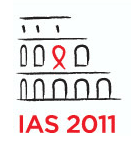 Truvada (tenofovir plus emtricitabine) reduced new infections among men who have sex with men and transgender women by more than 90 percent—if there was lab test evidence of them having actually taken the drug—according to final data from the iPrEx study reported at the 6th IAS Conference on HIV Pathogenesis, Treatment and Prevention in Rome.
Truvada (tenofovir plus emtricitabine) reduced new infections among men who have sex with men and transgender women by more than 90 percent—if there was lab test evidence of them having actually taken the drug—according to final data from the iPrEx study reported at the 6th IAS Conference on HIV Pathogenesis, Treatment and Prevention in Rome.
Across the board, there was a 42 percent reduction in new infections among those allotted to receive daily Truvada—averaging everyone together, whether or not they actually took their medication as prescribed—compared with placebo, in the 2,500-person study, in which everyone enrolled had access to a comprehensive package of prevention services.
The original report, authored by a team headed by Robert Grant, MD, of the University of California at San Francisco and published by The New England Journal of Medicine (NEJM) in November 2010, demonstrated there were 44 percent fewer HIV infections among those who were assigned to take Truvada for an average of 1.2 years. The slight decrease in the average protective benefit of Truvada PrEP in the final analysis, reported in Rome by Grant and his colleagues, was based on follow-up data extending out to nearly two years.
According to Grant, there were 48 infections among those randomized to the Truvada group, compared with 83 infections among those randomized to the placebo group.
What has been a major talking point, however, is the fact that iPrEx volunteers who actually took their Truvada as prescribed likely did much better than average. According to the NEJM report, there were 73 percent fewer HIV infections among those said they took their Truvada 90 percent or more of the time—as measured by pill counting and self-reports—compared with those who received placebo.
Given that pill counts and self-reports can be unreliable measures of adherence, the iPrEx team tested drug levels in the 48 study volunteers who became infected in the Truvada group and compared them with drug levels in 144 study volunteers in the Truvada group who didn’t become infected. According to Grant’s report in Rome—along with a second presentation by Peter Anderson, PharmD, of the University of Colorado—10 percent of those who became infected had study drug detected in their blood, compared with 44 percent of those who didn’t become infected.
This difference translated into a 92 percent reduction in new HIV infections among those with clear evidence of having taken the drug, compared with those who didn’t—at least not consistently.
As for those who became infected despite having detectable drug levels, Anderson noted that their levels were roughly half of those who didn’t become infected, meaning that they may not have been taking Truvada as prescribed in the study.
While some experts point out that the moderate 42 percent reduction in the number of new infections speaks to the likely effectiveness in real-world settings involving men who have sex with men and transgender women—which accounts for poor adherence—others argue that the 92 percent reduction among those with evidence of actually having taken the drug, even inconsistently—a best-case scenario, based on subset analyses of the study—is an important focal point as real-world feasibility studies get under way.
Returning to the larger analysis, there were no statistically significant differences among most subgroups in the study.
Efficacy of Truvada PrEP was no better or worse when Grant’s team looked at ethnicity, region or alcohol use.
Only in those who reported unprotected receptive anal intercourse (URAI) was there a statistically significant difference in efficacy, with a greater level of protection afforded to those who did report it, compared with those who did not.
And while efficacy appeared to be better among volunteers older than 25 (compared with those younger than 25), there was no statistically significant difference between those who had completed secondary/high school, those who were circumcised, and those who didn’t identify as transgender or were using feminizing hormones.
Grant also noted that the percentage of people who reported URAI decreased in both groups during the study, a finding that helps settle concerns of increased risky behavior among those using PrEP. Whereas roughly 60 percent of the volunteers reported having URAI before study enrollment, the rate consistently remained below 30 percent at all time points in the study. Even among those who believed they were getting Truvada, there was a decrease in the number of volunteers reporting URAI during the study.
“Oral [Truvada] PrEP provides additional protection against the acquisition of HIV among MSM receiving a comprehensive package of prevention services,” Grant said in his concluding remarks. “Detectable drug is associated with a 92 percent reduction in HIV risk after adjusting for other benefits, with no evidence of risk compensation, even among those who thought they were taking [Truvada].”






Comments
Comments